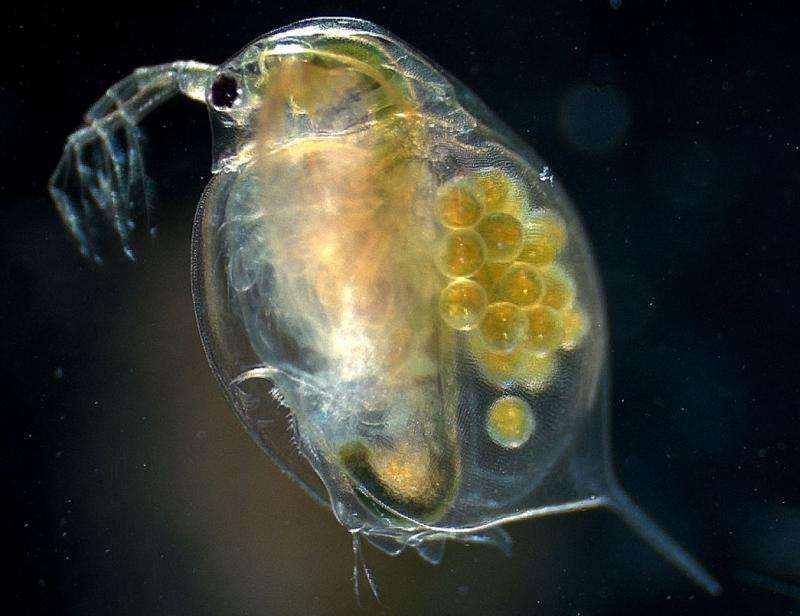Water fleas genetically adapt to climate change

The water flea has genetically adapted to climate change. Biologists from KU Leuven, Belgium, compared 'resurrected' water fleas—hatched from 40-year-old eggs—with more recent specimens. The project was coordinated by Professor Luc De Meester from the Laboratory of Aquatic Ecology, Evolution and Conservation.
The water flea Daphnia is a zooplankton organism that is typically found in shallow ponds and lakes. Under normal circumstances, water fleas reproduce asexually: they clone themselves. But in difficult living conditions - during food shortages or heat waves, for instance - they switch to a different type of procreation: they mate and lay dormant eggs. These eggs are in fact encapsulated embryos that are resistant to harsh conditions. A dormant egg can remain in the sediment of a pond for dozens of years and still be able to hatch.
As the dormant eggs remain viable for a long time researchers can use resurrection ecology to examine the evolution of water fleas in a changing climate. Biologist Aurora Geerts explains: "When water fleas reproduce asexually, their offspring is genetically identical to the mother. But when they mate, this results in genetic variation. The genetically fittest water fleas - the ones that are best adapted to the environment - survive and lay dormant eggs. When we hatch the dormant eggs of water fleas from the past and compare them with the contemporary population, we can reconstruct the evolutionary changes that occurred in that population and examine how they have adapted to the rising temperature of the water in which they live."
The biologists used dormant eggs from Felbrigg Hall, a shallow lake in England: "Both the water flea population and the changes in temperature of that lake are well-documented. Over a period of forty years the average temperature near Felbrigg Hall has risen with 1.15 degrees Celsius. In addition, the number of heat waves has tripled. This causes stress to animals that live in such shallow water. From a Felbrigg Hall sediment core we selected dormant eggs from sediment layers matching the period 1955-1965 and a more recent layer from 1995-2005. We collected eggs from both time periods and hatched them. Then we examined the heat tolerance of the resulting populations from these two time periods by scoring the temperature at which the water fleas lost motor function and fainted. The critical maximum temperature for activity for the water fleas from the recent sediment layer is half a degree more than 40 years ago."
In another experiment, the biologists examined whether current populations of the water flea Daphnia can genetically adapt to higher temperatures. "Over the course of two years we exposed a population of water fleas to two temperature treatments: ambient temperature and ambient +4°C. From the sediment of experimental units of both treatment groups we hatched dormant eggs. We then measured the heat tolerance of the water fleas under standardized laboratory conditions. For the water fleas that had been exposed to a heated environment the critical temperature for activity was on average 3.6 degrees higher than for water fleas from the control group."
The findings indicate that water flea populations can adapt quite rapidly to rising temperatures. The study is the first to show that animal populations can adapt and already have adapted to higher temperatures and increased heat wave frequencies - two results of climate change - by means of evolutionary changes in their heat tolerance.
The capacity for genetic adaption is, however, not enough to guarantee success, Geerts adds: "Climate change may have an impact on other factors as well. The water flea might be exposed to more enemies, less food, or an increased sensitivity to parasites. But our results show that we need to take into account the evolutionary dynamics of a species if we want to predict how it will respond to climate change."
More information: Rapid evolution of thermal tolerance in the water flea Daphnia", Nature Climate Change, DOI: 10.1038/nclimate2628
Journal information: Nature Climate Change
Provided by KU Leuven



















